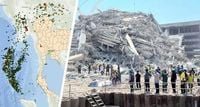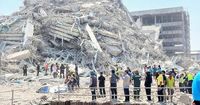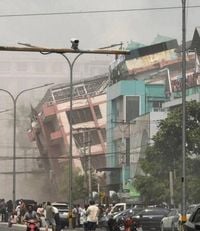A powerful earthquake with a magnitude of 7.7 struck Myanmar and was felt across neighboring Thailand, leading to a state of emergency in both countries. The tremors, which began around 12:50 PM local time on March 28, 2025, have resulted in multiple casualties, significant infrastructure damage, and chaos in urban centers.
The epicenter of the earthquake was near Mandalay, Myanmar's second-largest city, at a depth of 9.6 kilometers. Following the initial quake, an aftershock with a magnitude of 6.4 was recorded, prompting fears of further seismic activity. Reports from the U.S. Geological Survey indicated that the tremors were felt in several countries, including India, Bangladesh, Laos, and China.
In Myanmar, the government declared a state of emergency in affected regions, which include Sagaing, Mandalay, Magway, Shan State, Naypyidaw, and Bago. Authorities are currently assessing damage and providing assistance to victims. Reports indicate that residential buildings and transport infrastructure in Mandalay and Sagaing have been severely damaged.
Among the most notable damages, a historic palace in Mandalay, dating back to the mid-19th century, was reported to have sustained damage. Additionally, a bridge over the Irrawaddy River collapsed, with about five spans falling into the water. In Shan State, the eight-story Aung Pan hotel was destroyed, resulting in two confirmed deaths and approximately 20 people trapped under the rubble, as reported by DVB.
Rescue efforts are underway, with many people receiving treatment in state hospitals across Sagaing, Mandalay, and Naypyidaw. Eyewitness accounts suggest that the situation is dire, with numerous casualties reported.
In Thailand, the earthquake's impact was particularly felt in the capital, Bangkok, where a state of emergency was also declared. Prime Minister Phetthongthan Chinawat, who was attending a tourism meeting in Phuket at the time of the quake, interrupted the meeting to convene an emergency session. She ordered the establishment of a command center to coordinate the response to the disaster.
The Meteorological Department of Thailand initially estimated the earthquake's magnitude at 8.2 and warned of potential aftershocks that could threaten high-rise buildings in the city. An unfinished 30-story skyscraper in Bangkok collapsed, trapping dozens of workers under the debris. Reports indicate that at least three people have died, and around 90 are missing, primarily construction workers who were on site at the time of the collapse.
As chaos unfolded in Bangkok, tourists were seen fleeing hotels, and evacuation procedures were implemented in high-rise buildings. Videos shared on social media depicted the terrifying moments when buildings shook, and water splashed from rooftop swimming pools. The city’s underground and above-ground metro systems were temporarily closed, and all airports in the region halted operations briefly before resuming normal service.
In light of the situation, the Thai government has urged citizens and visitors to exercise caution, as experts continue to warn of the possibility of further seismic activity. The Department of Civil Aviation confirmed that airports in Bangkok are operating normally after a short closure of about 20 minutes.
According to the Russian Association of Tour Operators (ATOR), up to 2,000 Russian tourists may have been in Bangkok at the time of the earthquake, with about 500 being organized tourists on pre-arranged tours. Representatives from the Russian Embassy in Thailand are actively investigating whether any Russian nationals were among the victims.
Reports from the Russian Embassy in Myanmar indicate that they have not yet confirmed any injuries among Russian citizens, but they are monitoring the situation closely. The embassy stated, "Strong tremors were felt across the country, including in Naypyidaw and Yangon. There are reports of damage to residential buildings and transport infrastructure in Mandalay and Sagaing."
In the aftermath of the earthquake, the military junta that controls Myanmar, following a coup in 2021, declared a state of emergency in the central regions, including Mandalay and Naypyidaw. Eyewitnesses reported that part of the former royal palace in Mandalay was damaged, and a 90-year-old bridge in the Sagaing region collapsed, further complicating rescue efforts.
As the situation develops, both Myanmar and Thailand face significant challenges in responding to the disaster. Emergency services are stretched thin, and the full extent of the damage is still being assessed. With ongoing aftershocks and the potential for further earthquakes, authorities are urging residents and tourists to remain vigilant.
In summary, the earthquake has left a profound impact on both Myanmar and Thailand, with numerous casualties and widespread destruction reported. As rescue operations continue, the focus remains on providing aid to those affected and ensuring the safety of residents and visitors alike.








